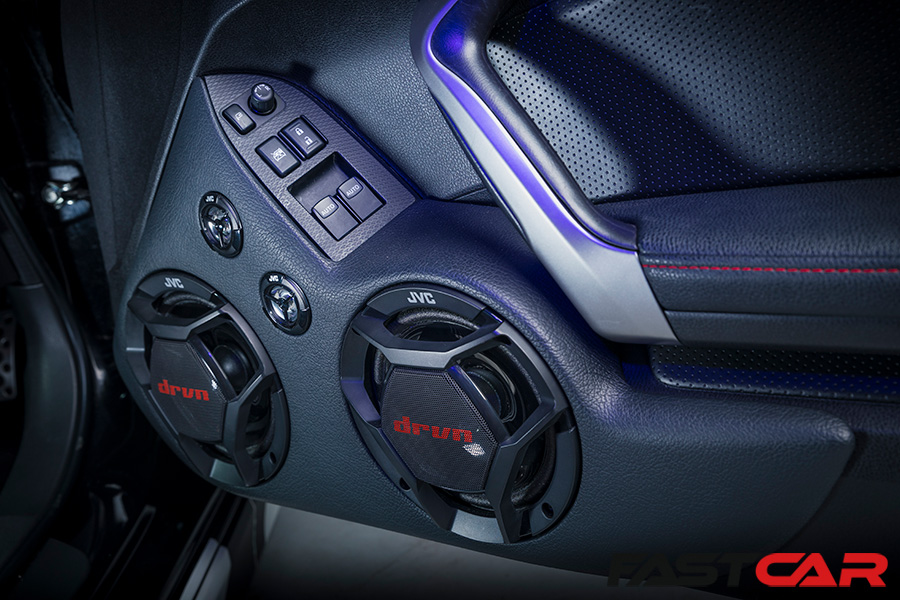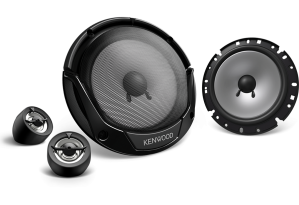Looking for the best component car speakers? Then look no further. Here are a selection of our favorites that you can buy today.
In the world of car audio, ‘Component’ is a cool buzz word, a bit like how everyone was obsessed with the word ‘Turbo’ in the ’80s. But why is that? Well, while coaxial speakers can and do produce incredibly high quality sounds, they are limited to their mounting. You can move the tweeters on the mounting pole of some coaxes but only by a few degrees of aim. However, with component car speakers, where the tweeter is separate from the mid-woofer, you can install the tweeter as you wish. We’ve even seen JDM component speaker sets where the tweeters are mounted in little pointy pods on stalks!
In essence, this flexibility means that the tweeters in a component system can be aimed precisely, and as the high frequencies are the most directional of all, this is pretty important for producing high-quality audio.
Car component speakers start off affordably, yet still give you tweeter-placement flexibility. You normally get a flush mount plus an angled mounting ring with the cheap to upper mid-price components, whereas fancy brands know you’ll be custom-mounting their products. For this guide, we’ll start at affordable and go up to proper posh. But first, a bit of tech guidance…
How to Aim Your Tweeters
This can be very easy. If you are plopping upgrade tweeters into stock locations, as you had separate mids and tweets, this is not relevant. But if you are installing a set of component speakers into a single OEM speaker location then try this:
Before you finally mount the tweeter, fit the mid-woofer as normal and wire in the tweeter on a foot of speaker wire. Allow that to come out around the edge of your driver – at this point you will not have made a hole for your tweeter wire/mount yet. Then, play the speakers with the tweeter stuck on a blob of Blu Tack! Yes – It’s a ‘superfluid’ like Silly Putty and even cornstarch oobleck. This means it seems soft but if you hit it hard, it is as rigid as hell.
The trick is simply to move your makeshift Blu Tack mount around the place and try different positions and angles until it sounds best. Don’t worry about the science. Just mess about until you like it.
Best Car Component Speakers
Kenwood KFC-E170P
RRP: $50.00 / £45.00. Buy it here.
The design brief for this set was about shallow mounting depth as well as affordability. The key to this product is the crucial separate tweeter that you can aim, as described above, which is achievable thanks to some extra plastic moldings for mounting the tweets and some small pods that hold the tweeter at an angle. You can aim those based upon their rotation as well. Stick these down with Blu Tack first and experiment with positions and angles for the best results.
This set’s passive crossover – the capacitors/coils/resistors – are not that sophisticated as it is an entry level offering. A lot like the simple single filter capacitor hidden under most coax speaker tweeters, this is an ‘in-line’ one. Just simple and incorporated into the supplied cabling.
Not rated at high power, only 30W RMS power handling, they are very good at turning watts into music though. That 92dB efficiency is exceptionally high. Whilst you lose the chance to run them on a powerful amplifier, they will transform a stock system. The grilles are smart looking, too. You’d never know they were so inexpensive. You can get these as a smaller 5.25 inch set of components as well, which is not a common size for the higher end brands at all. A lovely no-brainer upgrade, you get lots of stereo imaging improvement possibilities and they’ll make your stock system feel louder.
- Comprises: 17cm polypropylene cone, 25mm PEI tweeter
- Power Handling/Impedance: 30W RMS/4ohms
- Sensitivity: 92dB @ 2.83V (1W)/1m
- Frequency Range: 30Hz to 22kHz
- Made as: 5.25in, 6.5in
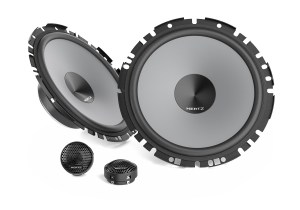
Hertz K-170 UNO
RRP: from $90.00 / £85.00 depending on size. Buy it here.
Another set of components that know their lot in life is to be stock replacements. Again, no fancy passive crossover, just a 6dB capacitor filter in the wire to the tweeters. These tweeters themselves have a slice of designed-for-car-use going on. No matter how well placed, Hertz know that you are still unlikely to be using handcrafted A-pillar speaker builds. So their tweeters are designed for good dispersion and to show a good off-axis performance. We touched on this in the coaxial speaker guide, where makers do the same thing with fixed tweets.
A smaller dome than some, the Hertz tweeter has a powerful Neodymium magnet. The main cones are simple pressed paper (still a hard to beat cone material) and have foam surrounds. Called a V-Cone® it is domeless and Hertz reckon it makes for better sound. This is speaker making technology filtered-down from their higher end products as Hertz have several ranges, some of which are seriously high end.
The K-170 UNO components main drivers have a really big 1in voice coil fixed to their behinds. Hertz state this is better for higher SPL or Sound Pressure Level and are pretty open about these being made to go as loud as possible. The best feature is the startlingly high 93.5dB efficiency. The extra money compared to the Kenwood gets you a phat 70W RMS power handling and every watt will rock through these.
- Comprises: 17cm V-Cone® woofer, 24mm NEO PEI dome tweeter
- Power Handling/Impedance: 70W RMS/4ohms
- Sensitivity: 93.5dB @ 2.83V (1W)/1m
- Frequency Range: 55Hz to 23kHz
- Made as: 5.25in, 6.5in, 6.7in
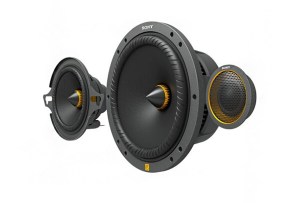
Sony XS-163ES
RRP: $599.00. Buy it here.
A jump straight to the serious now, with this set of Sonys and their new Hi Res rating. This means the tweeters can reach way up past what we used to think was the limit of human hearing. We now know that frequencies above 20kHz still matter like hell and we can somehow tell. Intended for use with the super high resolution streaming services that play music way more detailed than mere CD resolution – that, or a storage device with the mad-end files stored upon it – Hi Res needs fancy speakers to play. Sony’s ES line has always been a special one.
This system is our first three-way, with a separate mid and mid-bass driver, as well as the High Frequency. The cones of the mid and mid-bass are made of ‘Cellular Aramid Fibre Matrix’, which Sony used to call MCA. Essentially, it’s a special cellular material that is awesomely rigid and light. The cones’ surrounds are fancy, too. With a notched look, they stretch with a better linearity, meaning they wobble better and you get improved sound as a result. Both the mid-bass and the mid driver also have a phase plug in the middle, which is another feature known to help sound quality. All in all, it adds up to one heck of a spec for the three and a half inch driver in particular.
The tweeters are a delicious soft dome that can reach the bat-frequencies. The passive crossovers can take a single power feed and split it up between the three drivers. You can bi-amp them, a very rare feature, where you feed one passive with two amp channels. These are beautiful looking, and beautiful sounding.
- Comprises: 17cm Cellular Aramid Fiber Matrix cone, 3.5in 80mm NEO midrange, 25mm soft dome tweeter
- Power Handling/Impedance: 90W RMS/4ohms
- Sensitivity: 89B @ 2.83V (1W)/1m
- Frequency Range: 40Hz to 40kHz
- Made as: 6.5in, 6x9in two-way and this 6.5in three-way
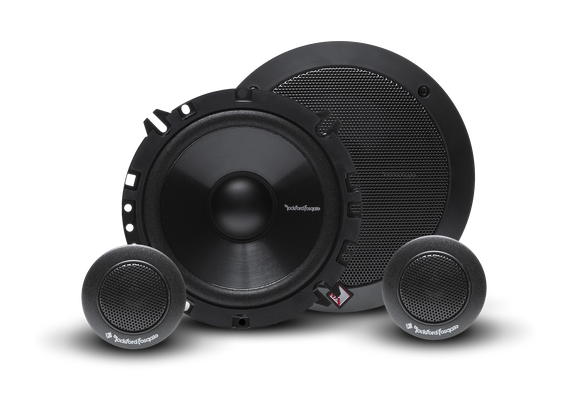
Rockford Fosgate Prime R165-S
RRP: $74.99 / £75.00. Buy it here.
Flush, surface and angle-mounting options for the tweeter, this system is again all about that first OEM upgrade. Another with the simple tweeter filter in-line rather than a fancy passive crossover network. The tweeter is only a half inch 13mm Mylar job, but this design can go loud! Made in the classic stock size of 5.25in, they also cater for both 6in and 6.5in, as seen here. Although inexpensive by Rockford terms, you are paying a little bit for the technical excellence.
Like all of Rockford’s speakers, even the entry level ones, they are measured with rigorous speaker-industry standard ‘Klippel’ analysis. This is a speaker specifications verification system, used by companies wishing to avoid the silliness of lesser outfits’ piffle claims. Also, the Consumer Electronics Association (CEA) in the USA set up their own set of ratings. When adhered to, it enables buyers to compare products’ specs in real world terms.
The RMS power rating for these is thus rock solid. There has been so much hogwash – and still is out there, that this is important stuff. So although the specs read a little weak for the money, their 80W max rating will be real, meaning that these speakers can take a spanking on a decently potent set of watts. They are Rockfords, play them hard!
- Comprises: 17cm Mica-injected polypropylene cone, 13mm Mylar dome tweeter
- Power Handling/Impedance: 40W RMS/4ohms
- Sensitivity: 89dB @ 2.83V (1W)/1m
- Frequency Range: 60Hz to 20kHz
- Made as: 5.25in, 6.5in, 6.75in
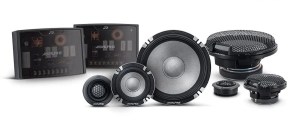
Alpine R2-S653
RRP: $599.95. Buy it here.
This is the Alpine next generation R series or R2. A high end range, their main drivers have die cast aluminum chassis. Tremendously Alpine in flavor, this set is made to take proper grunt and deliver visceral power yet with the crisp reach of a bat. They are rated as Hi Res audio capable, largely thanks to the crazy resolution and reach of the tweeters that can go to 40kHz.
R2 come as merely fabulous components, in 6×9 and 6.5 inch 2-way versions and as 6.5in and 6×9 coaxials. They also come as this ‘Pro’ level in two-way and three-way 6.5in. Also Hi Res rated, their chassis are a little shallower and they have a new cone material, which is an actual Alpine proprietary material. Alps have an incredible history in speakers and this is a serious investment in technology for car sound.
As a three-way system, R2-S653 comes with beautiful passive crossovers. You connect the full range power and the crossover acts as a traffic cop for sound, directing each frequency to the right speaker. A classic piece of Japanese design, you can adjust the output of the mid and tweeter. You can have 0dB or -3dB, or ‘+3dB’ by changing tiny controls within the passives. But it cannot ‘plus’ anything, as it’s passive, no amplifier. That means that Alpine ‘voice’ their tweeter a tad stridently and 0dB is in fact a tiny bit attenuated. We truly think we can hear the resistor take the sparkle off the high frequencies. As such, you’ll want to set the passives to ‘+3db’. At this level, I reckon you’ll own some fancy digital EQ already. If that’s the case, you can fix any issues without dulling the detail through a resistor.
- Comprises: 16.5cm glass fiber reinforced woofer cone, 96mm midrange (GFR), 43mm Hi Res tweeter
- Power Handling/Impedance: 100W RMS/4ohms
- Sensitivity: 88dB @ 2.83V (1W)/1m
- Frequency Range: 65Hz to 40kHz
- Made as: 6.5in and 6x9in two-way, and 2-way and (this) 3-way 6.5in ‘Pro’
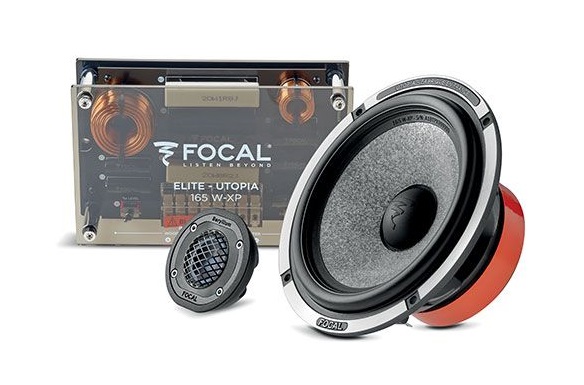
Focal Utopia 165W-XP
RRP: $2500.00. Buy it here.
There is only one passive crossover in the Utopia line. Most buyers will be purchasing just the drivers they need, to run them on a dedicated amp channel each – ‘actively’. You choose what sizes of drivers you want; you could even assemble eights with sixes and tweeters as a three-way active system. But if you have a great dynamic clean amp, these are amazing with a 4ch one to bi-amp them with. The ninth of nine ranges that comprises an incredible variety of car speakers, Focal’s Utopia line is the ultimate destination for some car audio sound quality competitors. Like the Sony X-ES passives, you can bi-amp the crossovers with a 4ch amplifier running dual stereo into them.
The TBM Beryllium tweeters are state of the art. Inverted metal domes, they have astonishing performance and cost way more than $1000 a set on their own. Beryllium is toxic and the set comes with a 44 page warning instruction in many languages about exactly that, but the results you get from this material are brilliant: three times faster sound wave propagation than titanium and two and a half times faster than aluminum. The linearity or smoothness and, above all, the ‘impulse’ are breath taking.
By impulse, Focal means rise time, which is how fast a sound gets louder. It’s hard to explain in words, but it’s what cats’ ears are good at and why they adore a papery rustle, and mice squeaks. Bells and things that go ting and tinkle have high rise times. A massively fast tweeter will give you goose bumps and you’ll even hear the mouth sounds of that vocalist – one for all you ASMR freaks out there! If well driven, the sound definition you get with these is practically unmatched.
- Comprises: 6.5in 6WM, and TBM Beryllium tweeter
- Power Handling/Impedance: 100W RMS/2ohms
- Sensitivity: 93dB @ 2.83V (1W)/1m
- Frequency Range: 60Hz to 40kHz
- Made as: separates, with only this kit assembled with a passive.
How the best component car speakers were chosen
While these products haven’t gone through our rigorous testing procedure, they have been recommended by Fast Car’s audio expert, Adam Rayner. Adam started his career in the music industry working with bands, before moving over to the manufacturing of speakers and eventually onto reviewing products for some of the biggest brands across the globe. He’s been obsessed with all forms of audio, but in car entertainment is where his interests lay most. The above products were chosen by Adam for their performance and standout features.

